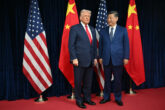November 01, 2018
Trumping Asia
In a cavernous Manila exhibition hall, flooded with light, U.S. President Donald Trump stood flanked by members of his national security team to deliver remarks to the press in November 2017. Joking that the White House press corps would need a day to recover from his first Asia trip – which covered five countries – the president observed, “It’s been an incredible 12 days. I’ve made a lot of friends at the highest levels.”
After intense public back-and-forth over Trump’s attendance at the 2017 East Asia Summit in the Philippines, he departed immediately following the leaders’ lunch, but before delivering official remarks. Officials cited a tight schedule, noting that the summit was running behind. Then-Secretary of State Rex Tillerson was left behind to speak in the president’s stead.
Nearly one year later, onlookers are still seeking clarity about the Trump administration’s Indo-Pacific strategy. Characterized by a newly declared strategic competition with China, “fair and reciprocal” trade deals, a free and open Indo-Pacific region, and increased emphasis on the Quad – a diplomatic grouping of Australia, India, Japan, and the United States – Trump’s approach is in some respects a predictable evolution of U.S. regional policy, while in other ways deeply disruptive. The administration’s ability to reconcile these competing forces into affirmative policy solutions will be the single largest factor that determines its relative success.
Read the full article in The Diplomat.
More from CNAS
-
North Korea Reveals Troop Dispatch to Russia amid U.S.-South Korea Policy Talks
North Korea has confirmed for the first time that its troops are operating in Russia, and it is preparing to rewrite its party charter with the possibility of officially namin...
By Dr. Go Myong-Hyun
-
Chinese Maker of Bitcoin-Mining Machines Is a Security Threat, Says Expert
Bloomberg News reports that a Chinese manufacturer, Bitmain Technologies Ltd, that sells most of the world’s Bitcoin-mining machines — including 16,000 of them to a venture ba...
By David Feith
-
Indo-Pacific Security / Energy, Economics & Security
North Korea’s Provocations, Power Plays, and Shifting AlliancesTensions on the Korean Peninsula have reached a new and dangerous threshold. President Lee Jae Myung is warning of a real risk of accidental military clashes, as the situation...
By Dr. Go Myong-Hyun
-
Indo-Pacific Security / Energy, Economics & Security
How to Win the Economic War with ChinaTrump's approach to China has run aground, giving Beijing unprecedented advantage in the economic conflict....
By Edward Fishman & Julian Gewirtz



